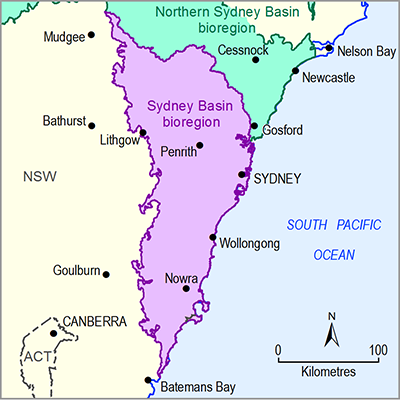To maintain and protect the health of rivers and groundwater systems, the NSW government established water sharing plans (WSPs) for the state’s aquifers under NSW’s Water Management Act 2000. The Act requires that water be allocated for the fundamental health of a groundwater source and its dependent ecosystems as a first priority. The water sharing plans are reviewed every ten years.
Most of the groundwater in the Sydney Basin bioregion is managed under NSW’s Water Sharing Plan for the Greater Metropolitan Region Groundwater Sources 2011. Other groundwater WSPs that cover parts of the bioregion are NSW’s Water Sharing Plan for the Murray-Darling Basin Porous Rock Groundwater Sources 2011 and Water Sharing Plan for the Murray-Darling Basin Fractured Rock Groundwater Sources 2011. The draft WSPs for the North Coast Groundwater Sources, Clyde River Unregulated and Alluvial Water Sources and South Coast Groundwater Sources, which are currently under development with a view to commencement in 2016, will manage extractions from the remaining groundwater sources within the Sydney Basin bioregion. Table 13 outlines the groundwater sources covered by the existing coastal water sharing plans. The locations of the groundwater source areas are shown in Figure 36.
Table 13 Commenced coastal water sharing plans and groundwater share components for groundwater sources in the Sydney Basin bioregion
adenotes that the water source area falls outside the Sydney Basin bioregion
bdenotes that only a portion of the water source area falls within the Sydney Basin bioregion
Data: NSW Office of Water (Dataset 2)
Table 13 provides a summary of the share components of the groundwater sources in the two commenced coastal WSPs for the Greater Metropolitan Region and Kulnura Mangrove Mountain. The groundwater share components in the draft WSP areas have not yet been finalised.
Generally, one share component is equivalent to 1 ML/year unless an available water determination (AWD; the volume of water available to licence holders for any particular water year) of anything other than 1 ML/share is issued. AWDs of less than 1 ML/share may be issued for aquifer access licences under WSPs to ensure compliance with the long term average annual extraction limits (LTAAEL) identified by the relevant WSP.
Alluvial and non-alluvial aquifers are present in the Sydney Basin bioregion and groundwater extraction from these aquifers is used for a range of purposes including domestic, stock, irrigation, town water supply and industrial purposes, with a proportion of water protected for the environment in all water sources. Groundwater entitlement (65,674 ML/y, Table 13) within the bioregion is relatively minor (approximately 5%) compared to surface water entitlement (1,206,835 ML/y, Table 19 in Section 1.1.5). However, some parts of the identified water sources are located outside the Sydney Basin bioregion, so the actual allocations may vary slightly from the percentage reported in this product. Groundwater and surface water usage and entitlements are discussed in companion product 1.3 for the Sydney Basin bioregion (Herron et al., 2018).
Figure 36 Groundwater source areas in the Sydney Basin bioregion
Data: Bureau of Meteorology (Dataset 3)


